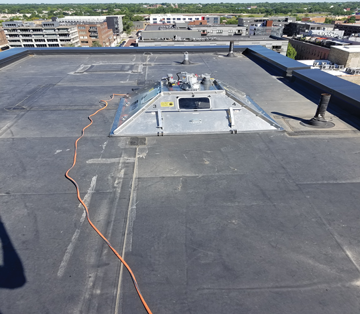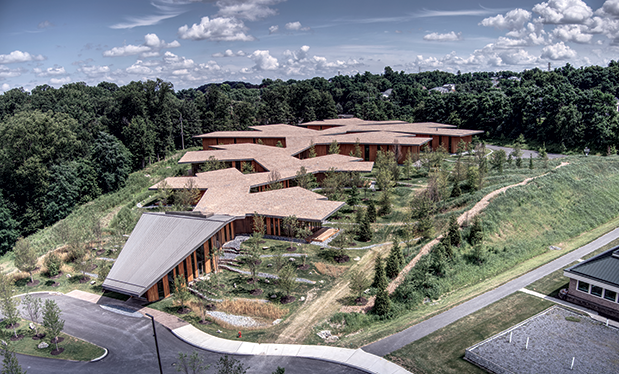
It has been a while since I have written about NRCA’s concerns with field uplift testing, which sometimes is inappropriately used as a way to assess the quality of an adhered membrane roof system installation. Despite the time that has passed, NRCA continues to have reservations about field uplift testing, and the test procedure has not yet been revised to address NRCA’s concerns.
ASTM E907
In 2013, ASTM International withdrew its consensus-based test method for field uplift testing, ASTM E907, “Standard Test Method for Field Testing Uplift Resistance of Adhered Membrane Roofing Systems.”
ASTM International requires its test method standards to include a precision statement addressing two things:
- Known within-laboratory variability, referred to as “repeatability”
- Relative variability of test results obtained from different laboratories, referred to as “reproducibility”
Test methods also are required to include an estimate of bias in test results.
ASTM E907 has lacked adequate precision and bias statements since it originally was published in 1983, and this is one of the reasons ASTM International withdrew the test method in 2013.
An updated and revised version of ASTM E907 currently is being developed. ASTM’s Committee E06 on Performance of Buildings previously was responsible for developing and maintaining ASTM E907 until it was transferred to ASTM Committee D08 on Roofing and Waterproofing in 2011. An ASTM Committee D08 task group responsible for the new version of ASTM E907 is conducting an interlaboratory study program to attempt to develop accurate statistical data that will result in precision and bias statements. NRCA is participating in this interlaboratory study program.
Once finalized and approved by the ASTM Committee D08 on Roofing and Waterproofing, the new version of ASTM E907 will be published with a new designation; the previous ASTM E907 designation will not be reused.
Until the new version of ASTM’s field uplift test method is published, the withdrawn version can be used.
FM 1-52
FM Global Property Loss Prevention Data Sheet 1-52, “Field Verification of Roof Wind Uplift Resistance,” is FM Global’s nonconsensus-based method for performing field uplift testing on FM Global-insured buildings in hurricane-prone regions.
FM 1-52 last was revised in July 2021. With this revision, FM 1-52’s scope clarified the test method can be used to assess existing roof systems for adequate wind resistance but not to determine the cause of wind-uplift damage after a storm event.
Reportedly, this change was made by FM Global after several of its insured clients had FM 1-52 field uplift testing performed on their aged, existing roof systems and found the tested uplift resistances were lower than their roof systems’ FM Approvals’ classifications. These building owners attempted to file insurance claims with FM Global based on the roof systems having experienced uplift damage.
Interestingly, FM Global’s scope change to FM 1-52 contradicts the specific reason why the field uplift test method was originally developed: Roofing contractors during the late 1960s and early 1970s were looking for a way to assess the extent of roof damage following Midwestern thunderstorms and localized high winds.
Whether the specific roof systems in these FM Global claims situations were storm-damaged or the differences are attributable to a lack of correlation between FM Approvals’ classifications and field uplift test results’ variations in test method procedures or known variations in field test method results is unknown.
For an article related to this topic, see “Assessing application,” October 2017 issue.
NRCA recommendations
NRCA maintains its long-standing position that field uplift testing is inappropriate for use as a post-installation quality assurance measure for adhered membrane roof systems.
NRCA maintains the best, most reliable means of assessing the quality of a newly installed membrane roof system is through continuous observation of the application at the time of installation by a knowledgeable roofing professional. NRCA’s Quality Control and Quality-assurance Guidelines for the Application of Membrane Roof Systems is meant specifically for this purpose.
NRCA encourages roofing contractors and manufacturers to consider avoiding projects where field uplift testing is indicated in construction documents as a basis for acceptance of roofing work. A roof system’s ability to pass wind-uplift tests and meet designated uplift pressures depends on numerous factors; a roofing contractor’s installation is just one.
If field uplift testing is being conducted but was not specifically called for in construction documents, you should go on record with your concerns regarding field uplift testing. You can use a copy of this column and other documents NRCA has published about field uplift testing as support.
You also should clearly stipulate your entitlement to final payment should not depend upon successful field uplift testing. Also, unauthorized field uplift testing (similar to any unauthorized roofing work) may void contractors’ and manufacturers’ guarantees.
I encourage NRCA contractor members to share their field uplift testing experiences and direct any questions regarding field uplift testing to NRCA’s Technical Services Section at (847) 299-9070, option 4, or nrcatechnical@nrca.net.
MARK S. GRAHAM is NRCA’s vice president of technical services.
This column is part of Research + Tech. Click here to read additional stories from this section.



